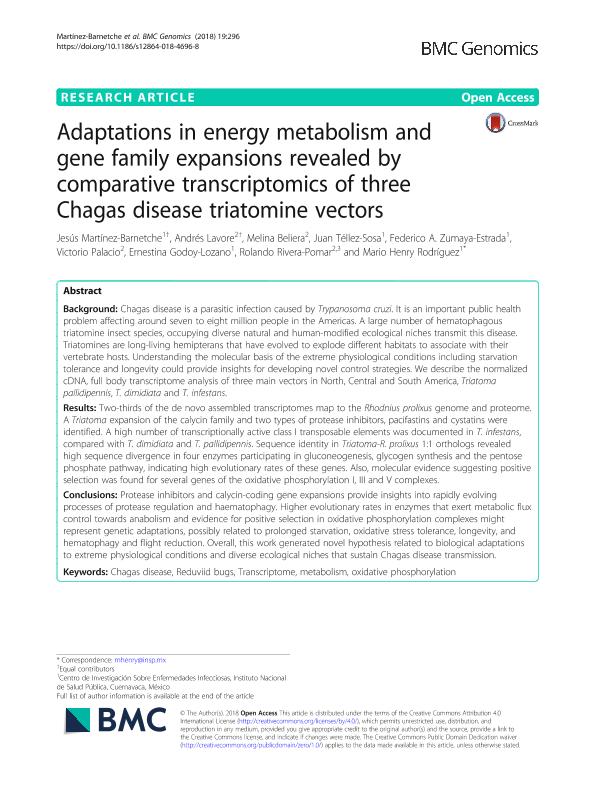Mostrar el registro sencillo del ítem
dc.contributor.author
Martínez Barnetche, Jesús
dc.contributor.author
Lavore, Andres Esteban

dc.contributor.author
Beliera, Melina Daniela

dc.contributor.author
Téllez Sosa, Juan
dc.contributor.author
Zumaya Estrada, Federico A.
dc.contributor.author
Palacio, Victorio Gabriel

dc.contributor.author
Godoy Lozano, Ernestina
dc.contributor.author
Rivera Pomar, Rolando

dc.contributor.author
Rodríguez, Mario Henry
dc.date.available
2020-02-03T19:53:10Z
dc.date.issued
2018-04
dc.identifier.citation
Martínez Barnetche, Jesús; Lavore, Andres Esteban; Beliera, Melina Daniela; Téllez Sosa, Juan; Zumaya Estrada, Federico A.; et al.; Adaptations in energy metabolism and gene family expansions revealed by comparative transcriptomics of three Chagas disease triatomine vectors; BioMed Central; BMC Genomics; 19; 1; 4-2018; 1-23
dc.identifier.issn
1471-2164
dc.identifier.uri
http://hdl.handle.net/11336/96572
dc.description.abstract
Background: Chagas disease is a parasitic infection caused by Trypanosoma cruzi. It is an important public health problem affecting around seven to eight million people in the Americas. A large number of hematophagous triatomine insect species, occupying diverse natural and human-modified ecological niches transmit this disease. Triatomines are long-living hemipterans that have evolved to explode different habitats to associate with their vertebrate hosts. Understanding the molecular basis of the extreme physiological conditions including starvation tolerance and longevity could provide insights for developing novel control strategies. We describe the normalized cDNA, full body transcriptome analysis of three main vectors in North, Central and South America, Triatoma pallidipennis, T. dimidiata and T. infestans. Results: Two-thirds of the de novo assembled transcriptomes map to the Rhodnius prolixus genome and proteome. A Triatoma expansion of the calycin family and two types of protease inhibitors, pacifastins and cystatins were identified. A high number of transcriptionally active class I transposable elements was documented in T. infestans, compared with T. dimidiata and T. pallidipennis. Sequence identity in Triatoma-R. prolixus 1:1 orthologs revealed high sequence divergence in four enzymes participating in gluconeogenesis, glycogen synthesis and the pentose phosphate pathway, indicating high evolutionary rates of these genes. Also, molecular evidence suggesting positive selection was found for several genes of the oxidative phosphorylation I, III and V complexes. Conclusions: Protease inhibitors and calycin-coding gene expansions provide insights into rapidly evolving processes of protease regulation and haematophagy. Higher evolutionary rates in enzymes that exert metabolic flux control towards anabolism and evidence for positive selection in oxidative phosphorylation complexes might represent genetic adaptations, possibly related to prolonged starvation, oxidative stress tolerance, longevity, and hematophagy and flight reduction. Overall, this work generated novel hypothesis related to biological adaptations to extreme physiological conditions and diverse ecological niches that sustain Chagas disease transmission.
dc.format
application/pdf
dc.language.iso
eng
dc.publisher
BioMed Central

dc.rights
info:eu-repo/semantics/openAccess
dc.rights.uri
https://creativecommons.org/licenses/by/2.5/ar/
dc.rights.uri
https://creativecommons.org/licenses/by/2.5/ar/
dc.subject
CHAGAS DISEASE
dc.subject
REDUVIID BUGS
dc.subject
TRANSCRIPTOME, METABOLISM, OXIDATIVE PHOSPHORYLATION
dc.subject.classification
Enfermedades Infecciosas

dc.subject.classification
Ciencias de la Salud

dc.subject.classification
CIENCIAS MÉDICAS Y DE LA SALUD

dc.title
Adaptations in energy metabolism and gene family expansions revealed by comparative transcriptomics of three Chagas disease triatomine vectors
dc.type
info:eu-repo/semantics/article
dc.type
info:ar-repo/semantics/artículo
dc.type
info:eu-repo/semantics/publishedVersion
dc.date.updated
2019-12-20T22:51:49Z
dc.journal.volume
19
dc.journal.number
1
dc.journal.pagination
1-23
dc.journal.pais
Reino Unido

dc.journal.ciudad
Londres
dc.description.fil
Fil: Martínez Barnetche, Jesús. Instituto Nacional de Salud Pública; México
dc.description.fil
Fil: Lavore, Andres Esteban. Consejo Nacional de Investigaciones Científicas y Técnicas. Centro de Investigaciones y Transferencia del Noroeste de la Provincia de Buenos Aires. Universidad Nacional del Noroeste de la Provincia de Buenos Aires. Centro de Investigaciones y Transferencia del Noroeste de la Provincia de Buenos Aires; Argentina. Universidad Nacional del Noroeste de la Provincia de Buenos Aires. Centro de Bioinvestigaciones (Sede Pergamino); Argentina
dc.description.fil
Fil: Beliera, Melina Daniela. Consejo Nacional de Investigaciones Científicas y Técnicas. Centro de Investigaciones y Transferencia del Noroeste de la Provincia de Buenos Aires. Universidad Nacional del Noroeste de la Provincia de Buenos Aires. Centro de Investigaciones y Transferencia del Noroeste de la Provincia de Buenos Aires; Argentina. Universidad Nacional del Noroeste de la Provincia de Buenos Aires. Centro de Bioinvestigaciones (Sede Pergamino); Argentina
dc.description.fil
Fil: Téllez Sosa, Juan. Instituto Nacional de Salud Pública; México
dc.description.fil
Fil: Zumaya Estrada, Federico A.. Instituto Nacional de Salud Pública; México
dc.description.fil
Fil: Palacio, Victorio Gabriel. Consejo Nacional de Investigaciones Científicas y Técnicas. Centro de Investigaciones y Transferencia del Noroeste de la Provincia de Buenos Aires. Universidad Nacional del Noroeste de la Provincia de Buenos Aires. Centro de Investigaciones y Transferencia del Noroeste de la Provincia de Buenos Aires; Argentina. Universidad Nacional del Noroeste de la Provincia de Buenos Aires. Centro de Bioinvestigaciones (Sede Pergamino); Argentina
dc.description.fil
Fil: Godoy Lozano, Ernestina. Instituto Nacional de Salud Pública; México
dc.description.fil
Fil: Rivera Pomar, Rolando. Consejo Nacional de Investigaciones Científicas y Técnicas. Centro de Investigaciones y Transferencia del Noroeste de la Provincia de Buenos Aires. Universidad Nacional del Noroeste de la Provincia de Buenos Aires. Centro de Investigaciones y Transferencia del Noroeste de la Provincia de Buenos Aires; Argentina. Universidad Nacional del Noroeste de la Provincia de Buenos Aires. Centro de Bioinvestigaciones (Sede Pergamino); Argentina
dc.description.fil
Fil: Rodríguez, Mario Henry. Instituto Nacional de Salud Pública; México
dc.journal.title
BMC Genomics

dc.relation.alternativeid
info:eu-repo/semantics/altIdentifier/url/https://bmcgenomics.biomedcentral.com/articles/10.1186/s12864-018-4696-8
dc.relation.alternativeid
info:eu-repo/semantics/altIdentifier/doi/https://doi.org/10.1186/s12864-018-4696-8
Archivos asociados
